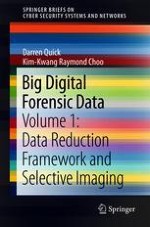2018 | OriginalPaper | Chapter
3. Data Reduction and Data Mining Frame-Work
Authors : Darren Quick, Kim-Kwang Raymond Choo
Published in: Big Digital Forensic Data
Publisher: Springer Singapore
Activate our intelligent search to find suitable subject content or patents.
Select sections of text to find matching patents with Artificial Intelligence. powered by
Select sections of text to find additional relevant content using AI-assisted search. powered by
